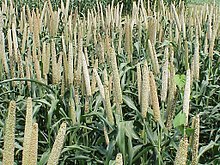**Cultivation and Domestication of Millet:**
– Millets belong to the grass family and are highly tolerant of drought and extreme weather conditions.
– Different millet species were domesticated in regions like East Asia, South Asia, West Africa, and East Africa.
– Pearl millet is the most common species, with finger millet, proso millet, and foxtail millet also being important crop species.
– Millet cultivation dates back thousands of years in various regions, such as China, Korea, Japan, India, and West Africa.
**Culinary and Nutritional Aspects of Millet:**
– Millet is used in various cuisines worldwide, such as in dishes like ragi in Karnataka, India, and millet porridge in Russian, German, and Chinese cuisines.
– Millet is high in protein, fiber, iron, and other essential nutrients, making it a valuable food source.
– Millet’s nutrient content varies compared to other staple foods like quinoa, teff, fonio, rice, and wheat, offering a range of essential minerals and nutrients for a balanced diet.
**Agricultural Importance and Usage of Millet:**
– Millet is used as a grazing forage crop for sheep and cattle due to its good water-use efficiency and high-temperature utilization.
– Millet is preferred over forage sorghum for faster animal weight gain and is planted after the frost period.
– Millet hybrids, especially pearl millet, play a crucial role in grain production, offering solutions to agrarian and nutritional challenges.
**Historical and Scientific Significance of Millet:**
– Millet has a long history of domestication, with evidence dating back thousands of years in regions like East Asia, India, and Africa.
– Millet played a significant role in ancient civilizations like the Indus civilization and has been subject to scientific research on crop production under stress conditions and nutritional attributes.
– Scientific studies have explored the archaeobotanical evidence of millets in the Indian subcontinent and the initial impact of millets in South Asia.
**Comparison with Other Staple Foods and Additional Information:**
– Millet is compared to other staple foods like cassava, rice, maize, wheat in terms of protein, fiber, iron, and sugar content, highlighting its nutritional benefits.
– Additional information includes millet-based alcoholic beverages, traditional foods like awaokoshi and bánh đa kê, and the significance of millets in various cultures and cuisines.
Millets (/ˈmɪlɪts/) are a highly varied group of small-seeded grasses, widely grown around the world as cereal crops or grains for fodder and human food. Most species generally referred to as millets belong to the tribe Paniceae.




Millets are important crops in the semiarid tropics of Asia and Africa (especially in India, Mali, Nigeria, and Niger), with 97% of millet production in developing countries. This crop is favored due to its productivity and short growing season under dry, high-temperature conditions.
The term millet is sometimes understood to comprise sorghum. The annual harvest of sorghum is twice the amount of other millets.[citation needed] Of these pearl millet is the most common. Pearl millet and sorghum are important crops in India and parts of Africa. Finger millet, proso millet, and foxtail millet are also important crop species.
Millets may have been consumed by humans for about 7,000 years and potentially had "a pivotal role in the rise of multi-crop agriculture and settled farming societies."
